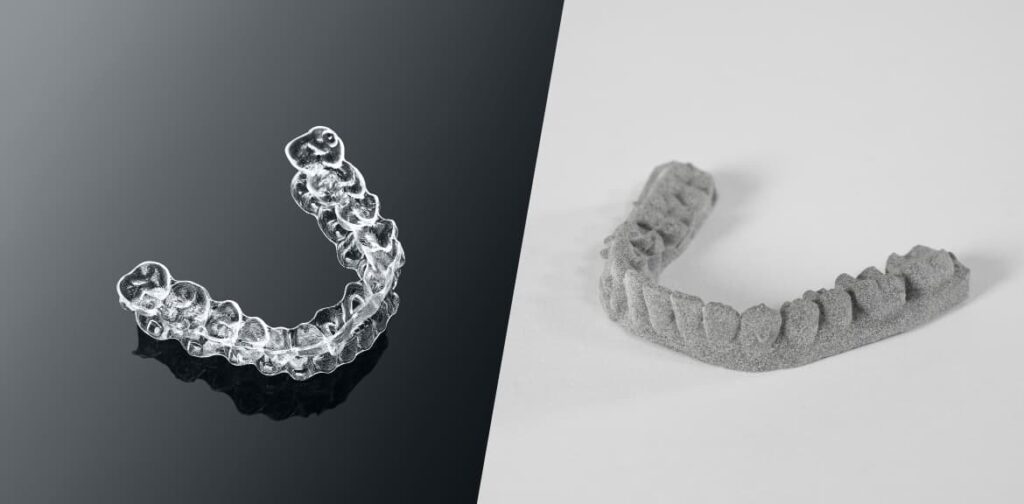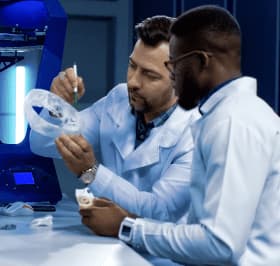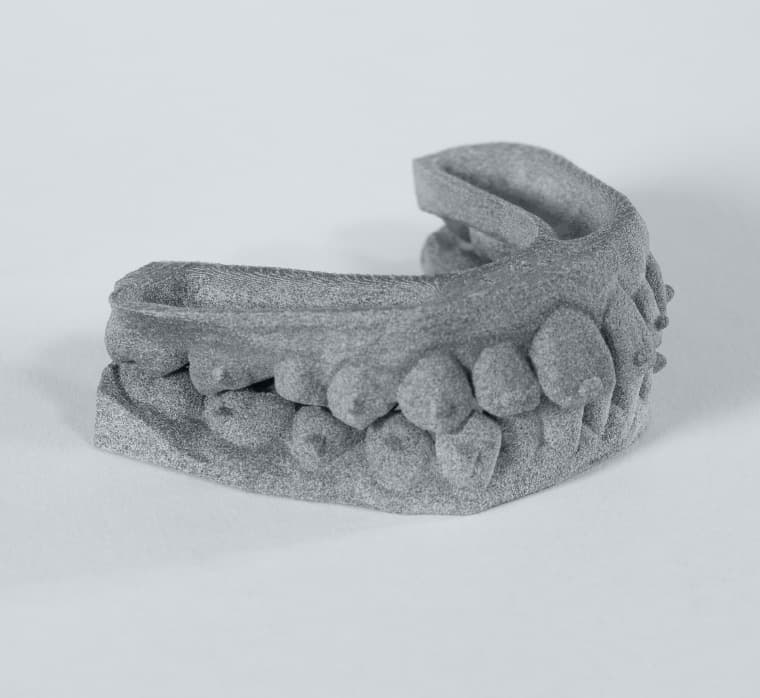How Multi Jet Fusion 3D Printing Rebooted Stomatology
3D printing is used in many fields, including stomatology. In this article, we explain how 3D printing helps to save costs and speed up the manufacture of teeth aligners.
How aligners work
Aligners (also called dental splints) are orthodontic appliances for correcting teeth misalignment. They are made to perfectly match your jaw and resemble a plastic casing that you put on your teeth. Corrective splints are produced from strong, flexible, and usually transparent material. The device applies slight pressure on the teeth, making them shift by fractions of millimeters and thus, gradually change position.
Doctors provide custom treatment plans for each patient. After agreeing on the final model, the treatment schedule is divided into stages. To ensure the desired result, the teeth need to be adjusted gradually. The patient receives a set of tailor-made aligners to wear each for two weeks. During this period, the teeth get used to the new positions. Then the aligner is replaced by the next one. The number of aligners needed changes case by case. A treatment cycle may require from 5 to 50 splints depending on the schedule.
How aligners are manufactured
To produce an aligner, a doctor needs a working model of their patient’s jaws. Traditionally, they are made by imprinting. The doctor presses against the patient’s teeth a special spoon with an elastic material that quickly solidifies (i.e. plaster or silicone). The patient has to hold the material in their mouth for several minutes to get a precise dental impression. Although the process is painless, it still causes discomfort to the patient:
- The material can get on the roof of the mouth, on the tongue, or in the throat and cause a gag reflex.
- Some dentists inject anesthetics to minimize saliva production.
- In some cases, doctors place a retraction cord between the gums and teeth to prevent bleeding and expose the roots of the teeth.
All these procedures are time-consuming and cause discomfort to the patient.
A solid dental impression is then scanned, after which the doctor works with a digital model of their patient’s jaw in a software application.
The model can be obtained by using an intraoral 3D scanner which takes a few minutes, does not cause any discomfort, and provides an exact copy of the patient’s jaw.
The ready 3D model is then uploaded into a software program. The doctor uses it to create a set of digital models for a treatment course. When the prototypes are ready, they are used to make aligners. A layer of elastic composite material is applied to the model which then is placed into a vacuum thermoforming machine. Under high temperature and pressure, the material melts and takes shape. It then solidifies as it cools, turning into a sturdy and firm structure.

Physical model printing
Creating jaw models requires high-precision 3D printing. Multi Jet Fusion technology, developed by the US company HP, can serve this purpose perfectly. This technology means aligners can be produced from powder by laser sintering. The printing layer thickness is 80 microns, which is equal to the width of a human hair. A resolution of 1,200 DPI ensures the high precision manufacture of aligners.
Another advantage of Multi Jet Fusion is high speed: it can print a batch of aligners within a few days, making the aligner manufacture process much quicker.
The benefits of 3D printing
3D printing has several advantages over the traditional production of working models.
1. Easier for both the dentist and patient
| Traditional dental impression methods are uncomfortable for the patient. The doctor needs to be highly skilled, as they can deform and damage the impression with one wrong move while taking it out. | The intraoral scanner does not cause any discomfort to the patient and considerably simplifies the doctor’s work. |
2. Faster
| It can take up to several hours or even days to obtain a digital jaw model and a jaw impression using traditional methods. In some cases, the patient has to visit the doctor and go over the procedure repeatedly. | It takes a few minutes to obtain a model with the intraoral 3D scanner. The model is ready for upload into the program once the oral cavity has been scanned. |
| Dental technicians form and create every model manually. It takes hours (or days in case there are multiple models). | Producing a batch of models on a 3D printing line takes a single day on average. The printing chamber volume allows the production of up to 400 models at a time. |
3. Guaranteed precision
| There is always some risk of inaccuracies in the traditional making of dental impressions. If the dentist uses a soft spoon, it could get deformed. They could also damage the impression if they are not careful when taking the spoon out. | Digital scanning allows for a precise image of the patient’s oral cavity. |
4. Simplified model production
| Traditionally, dental technicians produce each model manually. Each of those requires finishing. | 3D printing ensures that models are produced as exact copies of digital models. It nullifies the risk of getting a flawed aligner. The models do not need finishing. |
5. Duplicate aligners
| Generally, using traditional methods, only a single aligner can be made since the silicon impression is often unusable after creating an aligner. Plaster models also crumble and wear out. | Models printed on Multi Jet Fusion lines are made from strong, chemical- and heat-resistant PA 12 polyamide. |
6. Easy to store aligners
| Doctors need physical space to store plaster and silicone aligner models. | Digital models are stored in computer memory or the cloud. |
Many dental clinics successfully use Multi Jet Fusion technology. For example, France’s Biotech Dental makes jaw prototypes using HP equipment. It allows company specialists to save time, reduce costs, and ensure maximum precision.
3D printing in aligner manufacture saves time and resources, simplifying the work for doctors and dental technicians. Models printed on Multi Jet Fusion lines are strong and precisely replicate all the peculiarities of the patient’s jaw anatomy. You can learn more about the technology and order models at 3dprint.infomir.eu.


